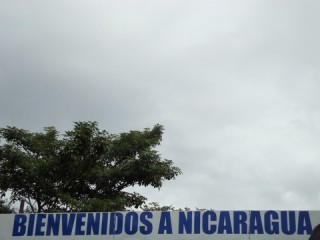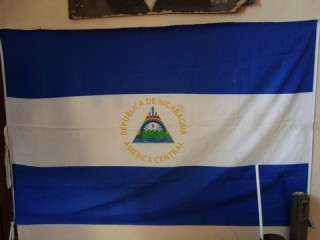Nicaragua calls itself the country of lakes and volcanos. To us it’s the country of the lakes, volcanos and hard wind. The wind blew very hard every day, fortunately we usually had it from the back or the side. There are many volcanos in the country and that was very visible. We never cycled outside the view of a volcano, one following another.
Nicaragua has a bit of a turbulent history which already started at the start of the 20th century when the country was invaded by the US. In 1933 they left the country again and Anastasio Somoza Garcia was elected head of The National Guard. During peace negotiations he ordered the murder of General Sandino (the man who freed the country of the Americans) and that order was followed on the 21st of February 1934. This was followed by a reign of terror by the National Guard. In 1936 Somoza came to power and in 1937 he called himself president. The corrupt and dictatorial family Somoza reigned the country till 1979. Anastasio Somoza Garcia was shot on Sep. 21st 1956 in the city of Leon and died a few days later. His son then came to power.
In 1979 the Somoza family was overthrown by the Sandinistic National Liberationfront (FSLN), the Sandinists, (named for the in 1934 killed General Sandino), a socialist guerrilla movement. They were inspired and supported by Cuba and they fought a guerrillawar against the dictatorship of the Somoza family. They formed the Committee of National Reconstruction which reigned the country till the Sandinist Daniel Ortega became president in 1985. Ortega lost the elections of 1990 and the Sandinists were no longer in charge. However, in 2006, Ortega got re-elected, in spite the call of the US (George Bush) not to vote for him. In 2011 he was re-elected again for a new 5 year term.
The US were afraid that communism would spread over America through Nicaragua and, from 1981, supported the contra’s who fought against the Sandinists. Those contra’s mainly existed of a group of armed forces who hated the Sandinistic regime. The most important group was the FDN which operated from Honduras and basically existed of former members of Somoza’s National Guard.
At the border, we instantly noticed that we had entered a whole different country than Costa Rica and Panama. It was a big chaos and it all looked sort of poor, even though there was a small mall-like building with a duty free shop. People say that Nicaragua is the poorest country of Central America, but you don’t really notice it that much. It doesn’t appear much different from the other countries over here. In Bolivia and Peru everything appears poor and there are not many (private) cars on the roads because people can’t afford one. Instead, there are many motorcycles and bicycles. But in Nicaragua there are a lot of cars and also many expensive cars. But besides that, there also were very many motorcycles, bicycles and horse and carriages.
We were surprised by the many tourists (mainly Americans, but also Germans) we saw in the country. We also were surprised by the many foreigners, mainly Americans, that live and/or work in the country.
We cycled through the south of the country, by the lakes Nicaragua and Managua. There are not many tourist attractions in the country. The volcano island of Ometepe, which exists of no more then 2 volcanos, Concepción (still active) and Maderas is basically the main attraction of the country. We visited the island and cycled around volcano Concepción. You can climb the volcanos but the summits are usually covered with thick clouds, so you can’t see much.
Besides that there are some beach towns where you can relax and enjoy sun, see and beach and there are the 2 colonial cities Granada and Leon. Leon has an enormous cathedral, the largest one of Central America.
We spent a few days in Leon and went to a museum about the warhistory in Nicaragua. We learned a lot about the wars that took place here. It was pretty impressive. About 120.000 people died in that period. Leon has been fighting over being the capital of the country with Granada for a long time. To end that, it was decided in 1858 that Managua was going to be the capital from then on. Besides that, Leon played an important part in the war between the troops of the Somoza and the opponents and everything that happened after.





































